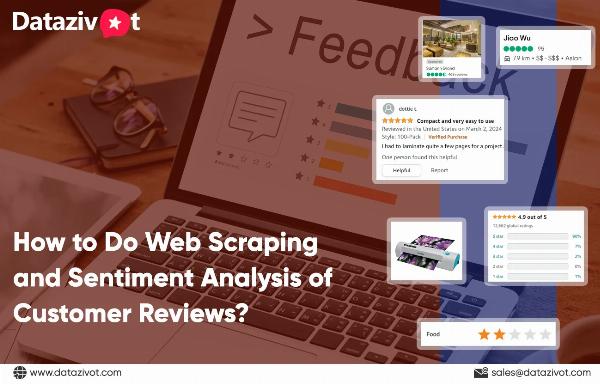How to Do Web Scraping and Sentiment Analysis of Customer Reviews?

Strong 8k brings an ultra-HD IPTV experience to your living room and your pocket.
How-to-Do-Web-Scraping-and-Sentiment-Analysis-of-Customer-Reviews Introduction In today's digital age, customer reviews play a pivotal role in shaping consumer decisions and influencing purchasing behaviors. Whether it's buying a product, booking a hotel, or choosing a restaurant, consumers often turn to online reviews to gauge the quality and reputation of businesses. As such, businesses recognize the importance of understanding and analyzing customer sentiments expressed in these reviews. In this comprehensive guide, we'll delve into the process of web scraping customer reviews and conducting sentiment analysis to extract valuable insights. Understanding Web Scraping Customer Reviews Understanding-Web-Scraping-Customer-Reviews Web scraping refers to the automated process of extracting data from websites. It involves using software tools or programming scripts to gather information from web pages. In the context of customer reviews, data extraction entails extracting text, ratings, and other relevant information from platforms where customers leave feedback. These platforms include review websites, e-commerce platforms, and social media channels. Purpose of Web Scraping Customer Reviews: The primary goal of web scraping customer reviews is to gather a large volume of feedback efficiently and effectively. This data can then be used for various purposes, such as sentiment analysis, product improvement, and market research. Data Extraction Process: Data extraction involves accessing the HTML code of web pages and extracting specific elements, such as review text, ratings, dates, and reviewer information. This process can be done manually or automated using extraction tools or programming scripts. Platforms for Customer Reviews: Customer reviews can be found on various platforms, including dedicated review websites like Yelp and TripAdvisor, e-commerce platforms like Amazon and eBay, and social media platforms like Twitter and Facebook. Benefits of Web Scraping Customer Reviews: By utilizing data extraction techniques, businesses can gather a wealth of customer feedback in a timely manner. This data can provide valuable insights into customer sentiments, preferences, and satisfaction levels. Challenges and Considerations: While data collection offers many benefits, there are also challenges to consider, such as data quality issues, website restrictions, and legal implications. Businesses must adhere to ethical guidelines and respect the terms of service of the websites they scrape. Integration with Sentiment Analysis: Once customer review data is collected through data collection, it can be analyzed using sentiment analysis techniques to categorize reviews as positive, negative, or neutral. This analysis provides further insights into customer perceptions and attitudes towards products or services. Use of Reviews Scraping API: Some review platforms offer APIs that allow businesses to access review data programmatically. This can streamline the data extraction process and ensure compliance with website terms of service. Web scraping customer reviews is a valuable technique for businesses seeking to gather insights from customer feedback. By extracting data from various online platforms and integrating it with sentiment analysis, businesses can gain a deeper understanding of customer sentiments and preferences, leading to informed decision-making and improved customer experiences. Methods for Extracting Customer Reviews Methods-for-Extracting-Customer-Reviews There are several methods for extracting customer reviews, including: Manual Web Scraping: This involves manually copying and pasting reviews from websites. While it's a straightforward approach, it can be time-consuming and impractical for large datasets. Automated Web Scraping: Automated data extraction involves using software tools or programming scripts to extract reviews from websites in a systematic manner. This method is more efficient and scalable, allowing businesses to gather a significant amount of review data in a short period. Reviews Scraping API: Some review platforms offer APIs (Application Programming Interfaces) that allow businesses to programmatically access review data. By leveraging these APIs, businesses can extract customer reviews directly from the source, ensuring data accuracy and reliability. Conducting Sentiment Analysis of Customer Reviews Conducting-Sentiment-Analysis-of-Customer-Reviews Sentiment analysis, also referred to as opinion mining, is a vital process for businesses aiming to understand the sentiments expressed within customer reviews. It involves analyzing the text of reviews to determine whether they convey positive, negative, or neutral sentiments based on the language used. Process of Sentiment Analysis: Text Analysis: Sentiment analysis begins with the extraction of text from customer reviews, which is typically obtained through techniques such as web scraping customer reviews or utilizing reviews scraping API. Categorization: Once the text is extracted, sentiment analysis algorithms categorize the reviews into different sentiment classes—positive, negative, or neutral—based on the language and tone used in the text. Language Patterns: Sentiment analysis algorithms identify specific language patterns, keywords, and linguistic cues that indicate the sentiment expressed in the reviews. For example, words like "excellent," "great," and "satisfied" typically indicate positive sentiment, while words like "poor," "disappointing," and "unhappy" convey negative sentiment. Scalability: Sentiment analysis techniques can be scaled to process large volumes of customer reviews efficiently. This scalability is particularly beneficial for businesses with extensive review datasets obtained through product review data scraping or similar methods. Insight Generation: By conducting sentiment analysis of customer reviews, businesses can gain valuable insights into customer perceptions, preferences, and satisfaction levels. These insights can inform decision-making processes, product improvements, and marketing strategies. Integration with Web Scraping Web scraping customer reviews is often the initial step in conducting sentiment analysis. By extracting customer reviews from various online platforms using data extraction techniques, businesses can gather the data needed to perform sentiment analysis effectively. This integration ensures that businesses have access to a diverse range of customer feedback, enabling more comprehensive sentiment analysis. Sentiment analysis of customer reviews is a powerful tool for businesses seeking to understand and leverage customer sentiments effectively. By combining data extraction techniques to extract customer reviews with sentiment analysis algorithms, businesses can gain valuable insights that drive informed decision-making and enhance customer experiences. Approaches to Sentiment Analysis Approaches-to-Sentiment-Analysis There are several approaches to conducting sentiment analysis of customer reviews, including: Rule-Based Sentiment Analysis: This approach involves creating a set of rules or patterns to classify text as positive, negative, or neutral based on keywords, phrases, or linguistic patterns. Machine Learning-Based Sentiment Analysis: Machine learning algorithms can be trained on labeled datasets to automatically classify reviews based on their sentiment. These algorithms learn to identify patterns and nuances in the language used in reviews, allowing for more accurate sentiment analysis. Benefits of Web Scraping and Sentiment Analysis Benefits-of-Web-Scraping-and-Sentiment-Analysis Insight Generation: By scraping customer reviews and conducting sentiment analysis, businesses can gain valuable insights into customer opinions, preferences, and pain points. These insights can inform decision-making processes, product development strategies, and marketing campaigns. Competitor Analysis: Data extraction allows businesses to gather customer reviews not only from their own platforms but also from competitors' websites and review platforms. By analyzing competitor reviews, businesses can identify areas where they excel or lag behind their competitors, enabling them to refine their offerings and improve customer satisfaction. Reputation Management: Sentiment analysis enables businesses to monitor and manage their online reputation effectively. By identifying and addressing negative sentiments in customer reviews promptly, businesses can mitigate reputational damage and maintain a positive brand image. Best Practices for Web Scraping and Sentiment Analysis Best-Practices-for-Web-Scraping-and-Sentiment-Analysis Respect Terms of Service: When extracting customer reviews from websites, it's crucial to comply with the website's terms of service and honor any restrictions or guidelines regarding data usage. Ensure Data Quality: Prioritize data accuracy and reliability when scraping customer reviews. Verify the integrity of the data and address any inconsistencies or errors that may arise during the extraction process. Regular Monitoring: Customer sentiment can evolve over time, so it's crucial to regularly monitor and analyze customer reviews to stay abreast of changing trends and sentiments. Conclusion Harnessing the power of web scraping customer reviews and conducting sentiment analysis presents Datazivot with unparalleled opportunities to delve deep into customer opinions, preferences, and sentiments. By adeptly leveraging these techniques, Datazivot can empower businesses to make informed decisions, refine product offerings, and secure a competitive advantage in today's ever-evolving marketplace. With Datazivot's advanced tools and methodologies, businesses can unlock the full potential of customer Reviews Scraping API as a wellspring of actionable intelligence. Let Datazivot be your guide to transforming raw data into strategic insights and propelling your business towards success. Embrace the future of data-driven decision-making with Datazivot today!
know more>https://www.datazivot.com/web-scraping-and-sentiment-analysis-of-customer-reviews.php
tag: #WebScrapingCustomerReviews,
#ExtractingCustomerReviews,
#SentimentAnalysisofCustomerReviews,
#ScrapeCustomerReviews,
#CustomerReviewsDataCollection,
Note: IndiBlogHub features both user-submitted and editorial content. We do not verify third-party contributions. Read our Disclaimer and Privacy Policyfor details.


